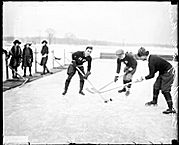| Entries |
| I |
|
Ice Hockey
|

|
Though most USAHL members lived in states bordering Canada, J. A. Tuthill's Ice Hockey and Polo Guide reported in 1898 that Chicago had a significant interest in hockey. The first clear institutional indication of Chicago's interest in ice hockey, however, came much later, when, in 1926, Major Frederick McLaughlin purchased an entire team from Portland, Oregon, and transplanted it in Chicago as the Blackhawks. Ice hockey came to Chicago because the National Hockey League wanted to expand, and McLaughlin's believed this “novelty” would justify his considerable investment.
Although the investment gradually paid off, other hockey programs were slow to follow. There were two short-lived Amateur Hockey Association teams: the Chicago Cardinals/Americans (1926–1927) and the Chicago Shamrocks (1930–1932). It was not until 1963, when the Elmhurst YMCA organized the first youth hockey program in Illinois, that a hockey tradition began to emerge from a growing number of city-sponsored outdoor rinks. Following the Elmhurst example, youth hockey emerged first in Lake Forest, Deerfield, Oak Park, Wilmette, Northbrook, and Chicago between 1963 and 1971. Early youth hockey was organized into “house leagues” in which youths (grouped from ages 8 to 18) competed intramurally, with occasional competitions between neighboring towns. Youth hockey was at first played on outdoor rinks. Only in the 1970s, after the Blackhawks captured their first NHL championship, were numerous indoor rinks built to accommodate the growing interest in hockey.
By 1972 local colleges including DePaul University, Lake Forest College, Northwestern University, and the University of Illinois at Chicago also had hockey teams. With the exception of UIC, these teams existed on a club basis and did not become affiliated with the NCAA. During the mid-1970s, Chicago was also home to two short-lived minor league teams, the Cougars and the Warriors.
The tremendous growth of hockey in Chicago during the early 1970s inspired the founding in 1975 of the Amateur Hockey Association of Illinois (AHAI), which is sanctioned by U.S.A. Hockey, Inc. With the possible exception of the Chicago Wolves, who came on the scene in 1994 as a franchise of the professional World Hockey Association and brought championships to Chicago in 1998, 2000, and 2002, the AHAI has been the most instrumental factor in the continued growth of hockey in Chicago. With 2,500 hundred members, the AHAI has supported hockey on all levels of play. In addition to seven age affiliations that range from pre-mite (age 3–5) to juvenile (17–18), the AHAI has also been instrumental in organizing hockey for girls and women. In 1998 the AHAI renewed its commitment to women's hockey by creating the Central States Hockey League, which boasts two “fifteen and under” teams and one “nineteen and under” team.
The Encyclopedia of Chicago © 2004 The Newberry Library. All Rights Reserved. Portions are copyrighted by other institutions and individuals. Additional information on copyright and permissions.